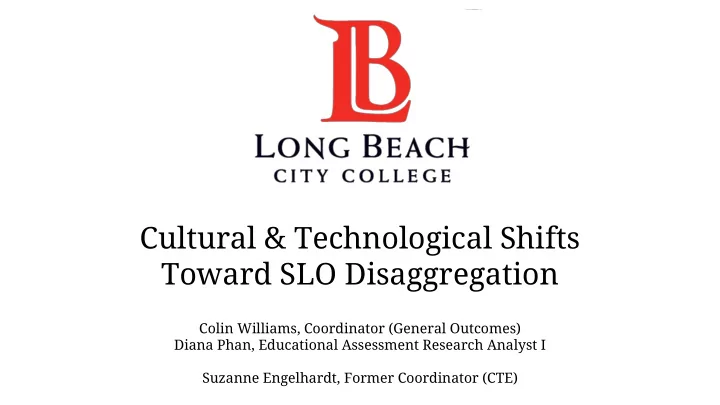

Cultural & Technological Shifts Toward SLO Disaggregation Colin Williams, Coordinator (General Outcomes) Diana Phan, Educational Assessment Research Analyst I Suzanne Engelhardt, Former Coordinator (CTE)
Adaptive Leadership Adaptive Leadership is concerned with how people change and adjust to new ● circumstances. It focuses primarily on how leaders help others do the work they need to do, in order to ● adapt to the challenges they face. This approach to leadership is also about helping others to explore and change their values. ● Northouse, p. 261, 273
Adaptive Leadership Behaviors 1. Identify Adaptive Challenges 2. Get on the Balcony 3. Create a Holding Environment 4. Orientation 5. Maintaining Disciplined Attention 6. Give the Work Back to the People
Leadership Behavior 1: Identify Adaptive Challenges ● Revised 2014 ACCJC Standards ● ACCJC 2015 Recommendation
Adaptive Challenge 1: ACCJC 2014 Revised Standards ● Standard I B.5: “..Quantitative and qualitative data are disaggregated for analysis by program type and mode of delivery.” ● Standard I B.6: “The institution disaggregates and analyzes learning outcomes and achievement for subpopulations of students.” Standard III.A.6: “The evaluation of faculty, academic administrators, and other personnel ● directly responsible for student learning includes, as a component of that evaluation , consideration of how these employees use the results of the assessment … to improve teaching and learning.”
Adaptive Challenge 2: ACCJC 2015 Recommendation ● Recommendation 2: “In order to meet the standards, the team strongly recommends the College s ystematically utilize student learning outcome assessment results to improve the achievement of stated student learning outcomes, and to inform integrated planning decisions, including resource allocation and improvements across the college .”
Leadership Behavior 2: Get on the Balcony ● Form a group of unofficial advisors Simply attend meetings as an observer. ● ● Step away from the conflict in order to see it fully.
Leadership Behavior 2: Get on the Balcony
Get on the Balcony. How We Did It ● Listen to faculty at large SLO Facilitator training ○ ○ Department FLEX Days and Meetings Presentations to Department Head Academy ○ ● Listen to shareholders in subcommittees CTE Subcommittee ○ ○ Curriculum Committee ASLO Subcommittee ○ ○ Department Planning / Program Review Subcommittee ○ Student Success Committee Academic Senate ○ ○ Bargaining Unit College Planning Committee ○
Leadership Behavior 3: Create a Holding Environment Establish an atmosphere so people feel safe tackling difficult problems. ● A holding environment is a structural, procedural, space formed by cohesive relationships. ● Northouse, p. 266
Create a Holding Environment. How We Did It Principles of Assessment Outcomes assessment is a faculty-driven process. It respects and builds on the contributions of all campus stakeholders to support students. ● Purposeful: Assessment should be conducted to enhance student success. Focused: Focus institutional resources on the structures, processes, and practices that ● support transformation. Nurturing: Cultivate a climate of respect, inclusion, and support for our internal and ● external communities and lead efforts to innovate and align resources that impact the educational, economic, and social outcomes for our Long Beach communities.
Leadership Behavior 4: Orientation ● Leader’s responsibility to orient people to new roles and responsibilities. Adopting new values may mean ● adopting new roles and institutional identity. Northouse, p. 266
Orientation. How We Did It New Processes & Roles New responsibilities for Facilitators and new responsibilities for departments ● o 20% Methodology o Updated Facilitator contracts o New Stipend Tiers o Greater detailed responsibilities Updates to the website with descriptions of roles, responsibilities, processes. ● o Online forms guide faculty along new processes ● Online Assessment Workbooks o Interactive Google Sheets
Leadership Behavior 5: Maintaining Disciplined Attention ● Adaptive leaders help people focus on issues. ● Supportive environments help members adapt. ● Face difficult problems directly. ● Distinguish between fantasy and reality. Northouse, p. 269
Maintaining Disciplined Attention. How We Did It Committee Membership & Presentations Augmented committee membership to present, share ideas, orient campus community ● Clear, Consistent Signalling & Communication ● Presentation at FLEX Day and FPD throughout the semester. o Responses to Concerns published In the Loop ● Presentations to o Academic Senate o Curriculum Committee o Department Head Academy o Department Planning & Program Review Subcommittee
Leadership Behavior 6: Give the Work Back to the People ● People want leaders to provide some direction and structure. ● Too much leadership and authority can be debilitating. ● Increase people’s confidence to solve problems on their own, foster creativity. Northouse, p. 271
Shifting Culture: How We Did It ● Resolution 52.3 Informed by precedent uncovered in a literature review. ○ ○ Collaboration between LBCC Academic Senate and LBCC Bargaining Unit Created clear & consistent signals for faculty. ○ Assessing with Canvas ● ○ Utilizing the LMS improves efficiency, Unifies Assessment Tasks across sections, ○ ○ Allows departments to disaggregate questions.
Assessing with Canvas: Increasing Usage
Assessing with Canvas: Types of Assessment
Assessing with Canvas by Department
Culture & Technological Shifts: Disaggregation ● Disproportionately Impacted Subpopulations ● Ethnicity ● Gender ● Other departmental preferences ○ Online vs. Face-to-Face ○ Major vs. Non-Major ○ Number of units taken concurrently
Culture & Technological Shifts: Disaggregating with Tableau
*Student Education Plans were used to identify student majors
*Student Education Plans were used to identify student majors
Summary: The Adaptive Challenges & Interventions ● Resolution 52.3 Revised 2014 ACCJC Standards ● ● Assessing SLOs on Canvas ● ACCJC 2015 Recommendation ADAPTIVE CHALLENGES LEADERSHIP
Cultural & Technological Shifts Toward SLO Disaggregation Colin Williams, Coordinator (General Outcomes) Diana Phan, Educational Assessment Research Analyst I
Recommend
More recommend